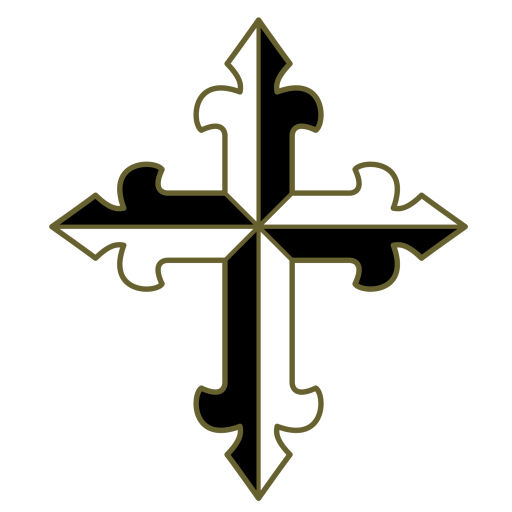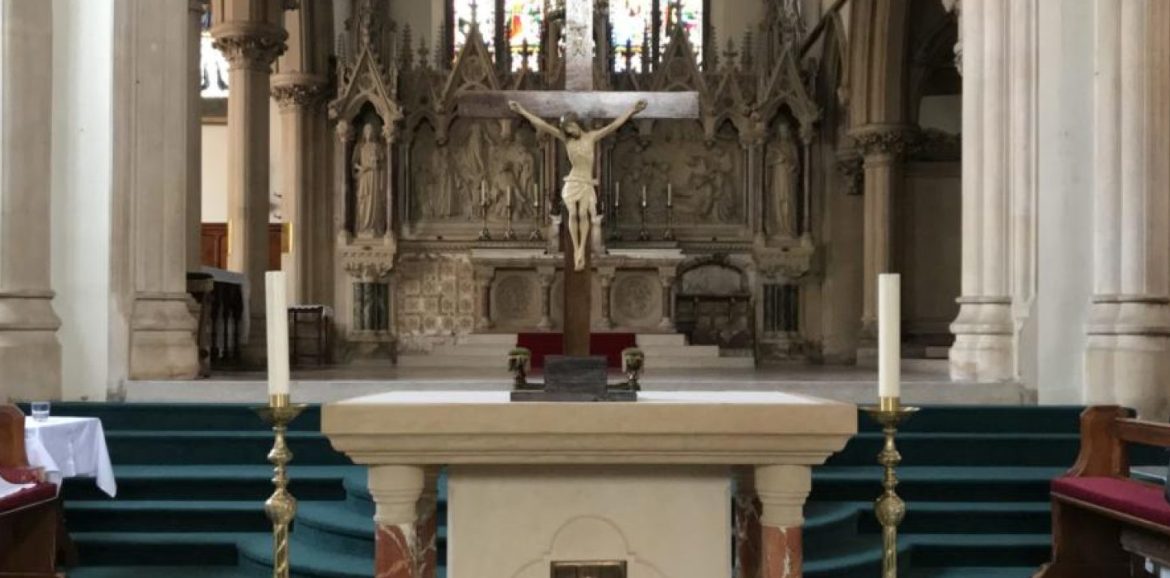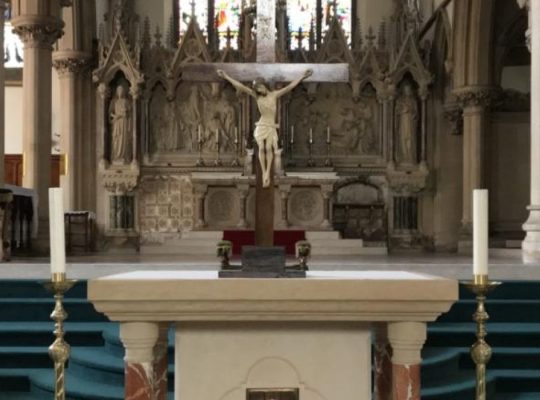The sacrament of the Body and Blood of Christ has always been the object of a great veneration expressed especially at the moment of Holy Communion. ‘No one eats this flesh without first adoring it,’ Augustine says. He does not speak thus in a sermon on the Eucharist but in a commentary on a Psalm. This means that prostration before the Blessed Sacrament was already part of the Communion rite in his time, a fit and proper veneration before God. As soon as Christians were able to build places of worship, they made provisions for a place [the Tabernacle] where, after the celebration, the Eucharistic species were taken with respect and even with a certain solemnity regarding Communion reserved for the sick. However, there was not yet what could be called a true worship of the Eucharist outside Mass. Although the Real Presence of Christ in the Blessed Sacrament has always been adored, it wasn’t until the ninth century and especially the eleventh century that various forms of adoration of the Blessed Sacrament outside of Mass really developed.
Processions of the Blessed Sacrament first appeared in Cologne between 1274 and 1279. It did not take long for the idea of processions to spread into most countries and to become the most characteristic and popular rite of this new solemnity. Even in the tiniest villages, people were at pains to give to this procession, according to their means, a fitting splendour. In the cities of Europe, the long cortege that went through the main streets adorned with draperies and banners was often impressive. The monstrance, in which a large host had been placed, was carried under a festive canopy, preceded by all the clergy and then followed by the civil authorities. Religious, confraternities with their banners, and the various groups had their assigned places according to strict etiquette. The procession paused at repositories that vied with one another in magnificence and where the Blessed Sacrament was set down while people sang a hymn; then the blessing with the Blessed Sacrament in the monstrance was given. The greatest number of people stood in the streets to see the procession pass by. They knelt as the Blessed Sacrament approached, or else they thronged around the repositories in order to receive the blessing. This Corpus Christi triumph publicly expressed the faith of an entire people acclaiming the Lord present in the host. There eventually came a time when this demonstration of faith in the Blessed Sacrament diminished and did not rally the majority of the population. Of course, processions still do take place on this solemnity in certain places. In the French Shrine of Lourdes however, there is a daily solemn procession of the Blessed Sacrament, concluding with benediction.
Since Vatican II, however, this Feast has been called the Body and Blood of Christ and not simply Corpus Christi. This change of name is significant. The emphasis is no longer on devotion to the Blessed Sacrament reserved in the tabernacle or processions and presented for the adoration of the faithful. The emphasis now is on the celebration of the Eucharist in the Sacrifice of the Mass and the reception of the Lord in Holy Communion, Body, Blood, Soul, and Divinity. This is why the preface of Holy Thursday [The day the Holy Eucharist was instituted by Christ at the Last Supper] is used.
‘Father, all powerful and ever living God, we do well always and everywhere to give you thanks through Jesus Christ our Lord.
He is the true and eternal priest who established this unending sacrifice.
He offered himself as a victim for our deliverance and taught us to make this offering in his memory. As we eat his Body which he gave for us, we grow in strength. As we drink his Blood which he poured out for us, we are washed clean.
Now, with angels and archangels and the whole company of heaven, we sing the unending hymn of your praise….’
As we turn our attention now to today’s Gospel, we see that, Matthew, Mark, and Luke report in equivalent terms the last paschal meal Jesus took with his disciples [The Last Supper]. Today we read Mark’s narrative.
‘Where do you want us to go and prepare for you to eat the Passover?’ Answering this question put by the disciples on ‘the first day of the Feast of the Unleavened Bread,’ Jesus sent two of his disciples into the city, saying, ‘a man will meet you carrying a jar of water. Follow him. Wherever he enters, say to the master of the house, ‘The Teacher says, where is my guest room where I may eat the Passover with my disciples?’’ The disciples did what they were told ‘and found it just as he had told them.’ They were shown ‘a large upper room furnished and ready,’ where they made the preparations for the celebration of Passover. Jesus seems not to have wanted it known in advance where this paschal meal was to take place. Was it as a precaution against those who had decided to arrest him and had already made a deal with Judas. Or was it simply a way of making sure that nobody would come to disrupt the intimacy of this last paschal meal he desired to share with the little group of disciples chosen ‘that they might be with him and he might send them forth to preach?’ In any case, it is clear that this Pasch, prelude to his passion, meant a great deal to Jesus and that he himself carefully organized its celebration to the last detail. ‘He had longed to share this meal with them.’
In contrast with the beginning full of concrete and vivid touches, the rest of the narrative is extremely spare. The ritual gestures made by Jesus are those of any head of a household at a festive meal: a blessing coupled with thanksgiving when taking the bread, then the cup as an acknowledgement that all these gifts come from God. To give a morsel of bread and to send the cup around were also usual practices in such a meal. However, Jesus had his own agenda too, something very special was about to happen at this meal. The words pronounced by Jesus when accomplishing these familiar gestures are extraordinary: ‘This is my body….this is my blood.’ The evocation of his death close at hand is obvious. Still more, his blood is ‘the blood of the covenant, which will be shed for many.’ Jesus did not merely make a prophetic gesture in order to announce that he was about to die. He proclaimed that he was giving his life to seal the new and eternal Covenant so that all may drink at the source of this life.
Mark—like Matthew—stylized the account. There is no mention of the meal prepared with so much care and attention: one would think that nothing but these gestures and these words happened. We know that this is not so, but, it is the pattern of the Christian Eucharist, that is given without any explanation but filled with all that Jesus did and taught. Such was the importance of this last meal with his apostles, there was no room for ambiguous language, no room for misunderstanding.
‘The extreme simplicity of these words and of the gestures that accompanies them mirrors the incomprehensible simplicity of God. What he had first unfolded, in the announcement of the Good News, embracing the multiple aspects of human complexity, Jesus now encloses at the Last Supper, without excluding anything, in a rite that boarders on insignificance. For only a sort of insignificance can signify the Abyss of the humility of Glory. Anything resembling explanation or feeling would obscure God instead of revealing them. At the hour he had most ardently desired, Jesus rigorously refrained from doing. ‘Body given…..blood of the Covenant shed for many….. take…..eat…..drink’; nothing more, whatever the differences between the four accounts. There is only the essential.’ (Fr. Carillon. L’humilite de Dieu)
During this last paschal meal eaten with his disciples, Jesus solemnly repeated the promise of his return, ‘Amen, I say to you, I shall not drink again the fruit of the vine until the day when I drink it new in the kingdom of God.’ The visible presence of Jesus ceased on earth the day of his ascension, but he is nevertheless present. The sacrament of the Body and Blood is the pledge of his presence. The Lord continues to invite us to his table until his return. The Eucharistic bread and wine have been given to believers to be their viaticum on the road of the exodus that leads to the definitive Pasch.
God has taken the initiative to offer his Covenant to humankind and, at the same time, he has shown them how they can live, all the days of their lives, in this relation of proximity and friendship that it establishes. To welcome this gift is to freely and without second thought commit oneself to put into practice ‘the words and ordinances of the Lord.’
Christ, the high priest of a covenant sealed in his blood, has entered, by his life and resurrection, into the heavenly sanctuary. In him, we have the mediator thanks to whom we can ‘worship the living God.’
Indeed, his Pasch has inaugurated the kingdom of the last times, which his return will establish. Then, the intimate Feast of the Eucharist will yield to the eternal and solemn thanksgiving of the elect celebrating the wedding of the Lamb. ‘Blessed are those who have been called’ to the Lord’s supper. By communicating here below with the Body and Blood of Christ, under the signs of bread and wine, believers receive the pledge of the promised heritage and prepare themselves to welcome the Lord on the day on which he will drink a new wine in the Kingdom of God.
HAPPY FEAST


